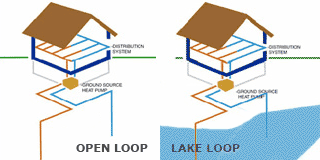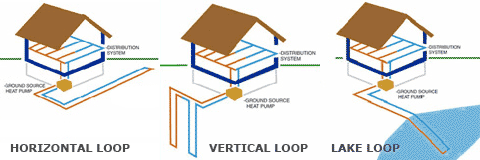GEOTHERMAL 101
• How Does a Geothermal Heating & Cooling System Work?
• The Benefits of Geothermal
• Frequently Asked Questions (FAQ)

How does a geothermal heating & cooling system work?
The temperature of the Earth’s core is over 4,000 degrees Celsius, with the inner heat radiating outward from the core and heat from the Sun radiating inward from the Earth’s surface. In the province of Ontario, the Earth’s temperature stays constant in the top 200 meters of the crust, ranging from 6-11 degrees Celsius depending on the region’s seasonal temperature.
Geothermal HVAC systems utilize energy extracted from the Earth and is able to dependably distribute heating and cooling no matter what the climate as the energy extracted remains at a constant temperature throughout the year.
10
Myths about Geothermal Heating and Cooling
10

There are two ways to harness the Earth’s energy
OPEN LOOP
An open loop system pumps water from a body of water (well, pond or lake) and returns it to surface water or an injection well.
CLOSED LOOP
A closed loop system utilizes a grid of pipes to pump heat transfer fluid through either a horizontal or vertical circuit of underground piping between the ground and the building.


In the winter a building is heated by collecting heat from the Earth and brought to the heat pump which concentrates the heat and supplies it to the building at 35 degrees Celsius. This process produces 3-4.5kW of heat for every kW of electricity used. Similarly, in the summer the heat pump removes the heat from the building, transferring it to the Earth. As the Earth is cooler than the air in the summer, this system allows for efficient air conditioning consuming 50-70% less electricity than conventional air conditioning systems.
Watch how geothermal heat pumps heat and cool buildings by concentrating the naturally existing heat contained within the earth… a clean, reliable, and renewable source of energy.

To heat or cool a building, an electric heat pump is used to concentrate the energy in the fluid from the Earth, using technology similar to that used in refrigerators. The system can be used with both forced-air and hydronic (hot water) heating systems.

There are both environmental and financial benefits to using a geothermal HVAC system.
With the prediction of the future decline in production of fossil fuels, governments worldwide need to develop energy conservation strategies that include an increased use of renewable energy. By harnessing the heat from the ground, a geothermal system reduces the dependence on fossil fuels and subsequently the building’s overall carbon footprint.
The increased efficiency and lower consumption of electricity than conventional systems make geothermal systems a more cost-effective option in the long run. The initial investment of installing a geothermal system is offset by the monthly savings in utility costs, which are only moderately affected by the fluctuating fossil fuel and electricity costs. When properly installed, the piping in the earth has a very long shelf life and the maintenance expenses have proven to be less expensive than solar, wind and traditional power sources.
The Benefits of Geothermal
FAQ – Frequently Asked Questions
-
How much does it cost to install a geothermal system?
-
Can a geothermal system heat my pool?
-
Is it possible to retrofit a home or building using oil or gas hot water heat to geothermal?
-
Can a lake, stream or pond be used as the geothermal source?
-
Is geothermal recommended for summer homes?
-
What advantages are there for installing a geothermal system in a commercial building?
-
What are the major benefits to home/building owners compared to conventional HVACR systems?
-
Are there uses for geothermal systems other than heating and cooling?
-
How does a geothermal system differentiate from a conventional system?
-
What is the difference between geothermal systems and air-source heat pumps?
-
Can you integrate geothermal with a HRV unit?
-
Can a home or building owner install a geothermal system on their own?
-
Can a geothermal system be located in a septic bed?
-
How long does it take to install a geothermal system?
-
Are there factors that can decrease the performance of a geothermal system?
-
What happens to the performance of the geothermal system when the temperature outside gets really cold?
Should you have specific questions regarding the installation, cost or performance of a geothermal system, please visit
CSA – C448 Design and Installation of Earth Energy Systems
Industry Associations
Air Conditioning & Refrigeration Institute
Canadian Geoexchange Coalition
Canadian Geothermal Energy Association (CanGEA)
Cascadia Chapter – U.S. Green Building Council
Earth Energy Society of Canada
Geothermal Heat Pump Consortium (GHPC)
Geothermal Exchange Organization (GEO)
Heating, Refrigeration & Air Conditioning Institute of Canada (HRAI)
International Ground Source Heat Pump Association (IGSHPA)
International Heat Pump Centre
Radiant Heating/Cooling Panel Association
National Resources Canada (NRCan)
RETScreen pre-feasibility analysis, ground-source heat pump module
